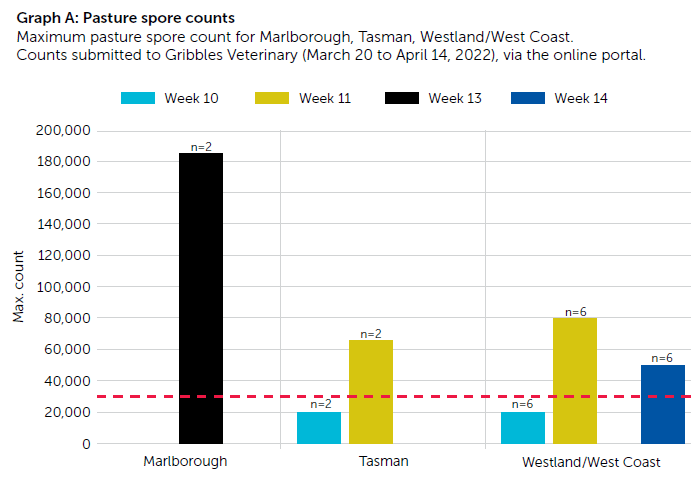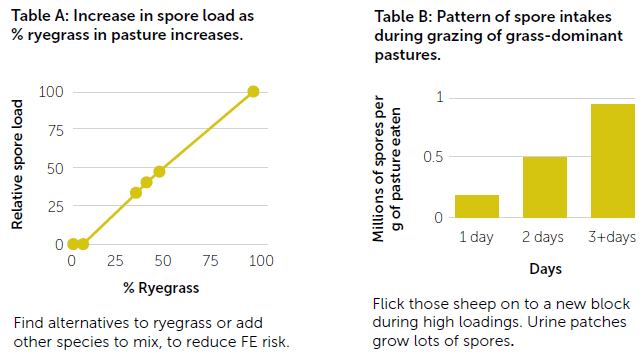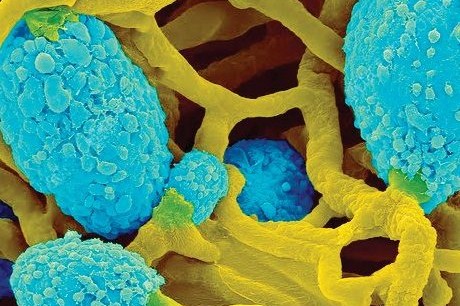South Island farmers are having to get used to coping with the scourge of facial eczema. By Joanna Grigg.
Get ready – it’s here. High spore counts and facial eczema (FE) in sheep show the pasture-related disease was in Marlborough in summer and autumn. Comments from farmers suggest it may have been affecting stock even south of the Awatere River.
Scanning results show top-of-the-south flocks had unexplained dry rates, despite good feed quantity and high ewe condition. Fungal toxins were likely at work, following 200mm of rain in February, warm nights and a build-up of dry material in pasture. Cases of FE were confirmed in lambs in March. Flocks tupped on crops such as kale, fared better, with normal dry rates. This points to a pasture-related problem.
Other signs hinted at an issue – ryegrass staggers in cattle and horses arrived earlier and was more intense.
Hill country pastures that couldn’t be controlled late summer had visible red rust which left a coating on boots. Vineyards were fighting serious botrytis infections on grape bunches. These all indicate classic conditions for fungi.
Other grass toxins, such as zearalenone, might have been at play and interfered with ovulation. Farmers were left scratching their heads as high dry rates were, in general, matched by higher than usual multiple rates. A post-mortem liver test can confirm subclinical FE and many farmers may have missed the opportunity when culling dry ewes.
A spore count result from Marlborough (see Graph A) showed a high level of 185,000 spores/gram (g) in early April. Gribbles Veterinary recommends that farmers kick-off facial eczema prevention strategies when local pasture spore counts are trending upwards of 30,000 spores/g and weather conditions look favourable for sporulation.
Gribbles Veterinary marketing administrator Karen Cooper says Gribbles provides the FE reports as a public service. Vet clinics load pasture spore counts, done through their practices, to the Gribbles portal. Farmers can get access by subscribing to the emailed reports.
“Farmers can use it as an indicator, to see when they need to start testing their own farms.”
Gribbles says no spore counts are being loaded by Canterbury clinics. A couple of clinics are loading results from West Coast and Tasman.

North Canterbury Veterinary Clinic’s vet Ian Page believes sheep and beef farmers in his area are not at all prepared for facial eczema.
“We have no experience.”
Page says one North Island dairy farmer who moved south to Cheviot did raise the issue once as a possibility.
“But sheep farmers are starting to talk about it now – we discussed mycotoxins in a farm discussion group in autumn…”
He says North Canterbury farmers are great at managing a dry summer, but this autumn was a classic North Island one, with moisture and warmth bringing parasites. Like Marlborough, the area had an unusual scanning. Page says most overall percentages were normal to good, but characterised by high dry rates of 10%, yet high multiple rates. Two-tooths were worst affected with up to 10% dry, when usually 5% would be considered high.
Page puts this down to parasite issues but doesn’t rule out fungal toxins either.
“This season no-one could contain the pasture growth and quality.”
Page says zearalanone, which has a daily effect on oestrogen levels when consumed, is difficult to test for, so a farmer needs to assume it’s just there in the pastures.
It requires a urine sample “pee in a jar” from a ewe.
“…you can’t take a meaningful blood test,” Page says.
He suggests farmers plan to mitigate effects by offering grain to ewes and crops for 10 days either side of mating. If conditions are right for ryegrass staggers then fungal toxins are likely.
If farmers were wanting to test for past FE damage, he suggests liver biopsy at slaughter. Even checking the liver of a dog-tucker sheep will be insightful.
“Look for a darker, hard liver, compared to a healthy bronze-coloured one.”
Eczema or scald on stock can also be caused by green feed crops, so get advice. Page predicts that it won’t be a rampant sudden arrival of facial eczema into Canterbury, but rather a slow change.

Farmer vet spots facial eczema
With a farm in the Marlborough Sounds and a veterinary job in Marlborough, Mary Bowron is well placed to confirm facial eczema is affecting stock in the South Island.
“It’s been seen in a few sheltered places in north Marlborough for several years, but this year it was more widespread.”
Mary and her partner Craig Robinson’s 120-hectare farm is in Waitaria Bay in Kenepuru Sound, a 50-minute boat ride from Havelock. They bought a flock of in-lamb Romney ewes, with unknown FE genetics. They were expecting a possible problem, as the stock had no resilience to FE-causing toxins, but they were not expecting such a challenging season.
Craig started spore counting in January and tested right through to June, noticing two big peaks in spore counts. One of the highest spore counts they had was 80,000, which is moderately high. The ongoing lower levels of spore counts causing chronic exposure can also cause clinical signs of FE. They were managing the risk by not grazing too low and using “safe paddocks”, such as hilltop and exposed paddocks.
“The second peak of 80,000 spore counts on the pasture got us – combined with ongoing loading of spores for a long time,” Mary says.
This was caused by a second warm period with high humidity and resulted in about 2% of the flock with clinical signs of FE, and some deaths.
“It wasn’t a total disaster, but more ewes will have sub-clinical effects, which will carry on affecting them.”
Dry rates were still a respectable 3%, but Mary is suspicious that some abortion in ewes post-scanning may be related to stress effects from FE. Over tupping, ewes were on higher pasture covers, away from sheltered areas that favour production of more toxins.
Ewes were moved every few days, to avoid grazing too low. Zinc capsules were considered but they opted not to. Two treatments of zinc capsules would have been needed as one treatment only lasts six weeks, Mary says. There was also a high demand across the country for zinc capsules. The couple will consider capsules next year, as the farm is an all-grass system with no crops grown to provide a safe area.
This season’s rams were selected for FE-tolerance from a North Island stud. They’ll start spore counts early and do them every week across a range of paddocks.
“We do the spore count ourselves – it’s not very technical but you do need to find a microscope,” Mary says.
Project finds fungi
A Beef + Lamb NZ- (B+LNZ) funded facial eczema (FE) research project, testing North and South island pastures, has found multiple strains of the fungi that cause FE – pseudopithomyces species.

These fungi require 100% humidity and 10–30C days, to start producing the potent mycotoxin sporidesmin. The work was carried out by AgResearch and Landcare Research.
Warwick Lissaman, farming south of the Awatere River, Marlborough, had five paddocks tested as part of the project. Interim results show one pasture sample positive for the presence of a fungus that can cause FE. He is now looking at using kale crops more extensively in autumn to protect ewes in time of fungal toxins on ryegrass and clover pastures.
“I think the short-term option is to limit the ingestion, which means alternative crops.
“But can we get crops in a big enough area for over the danger time, or should we hard feed?”
B+LNZ senior adviser research programmes Dr Cara Brosnahan (not a family member – Ed) confirmed preliminary results show the fungi were widespread in the pasture samples. The full report is due September, but preliminary results suggest two different species have been found across the North Island and upper half of the South Island, after testing 34 farm sites.
The bottom line is the fungi is here and, as warm moist conditions occur further south, the risk to stock from FE will grow. Understanding more about all the factors that contribute (pastures, soils, environmental conditions) is on the research wish list for Brosnahan. B+LNZ has applied for funding through the Sustainable Farming Fund (40% contribution) to help answer these questions.
New technologies, such as DNA testing of fungi, have changed the way researchers can investigate the actual process of fungal toxins being produced.
Another B+LNZ-funded project underway is to find better ways to support farmers faced with FE pressure on stock.
Brosnahan says nothing has been done on the social impacts of the disease so a pilot study by AgResearch with 14 study farmers and rural professionals is under way.
They are looking at the effect on farmers in endemic areas, as well as areas new to facial eczema, with the purpose of finding out what information and support they need.






